Hellebori nigri, Black HelleboreChristmas Rose; MelampodiumHelleboraster (H. foetidus) Kharbaq (Unani) |

|

|
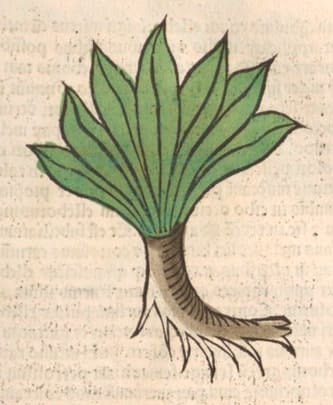 Herbarius latinus, Petri, 1485
Herbarius latinus, Petri, 1485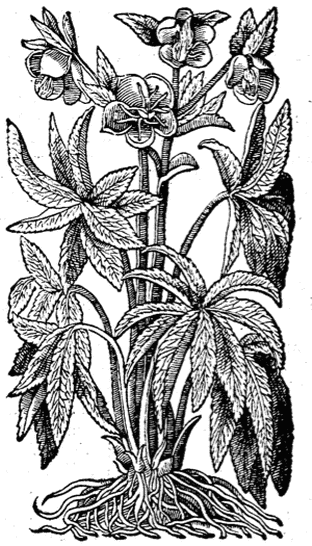 H. niger
H. nigerMesue, Opera de Medica, 1589
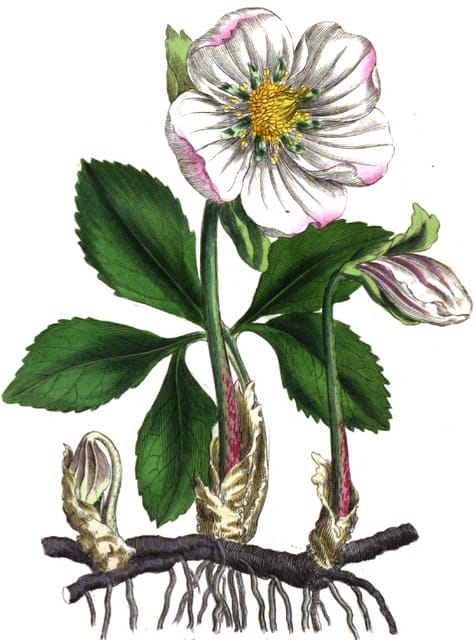 H. niger
H. nigerMedical Botany, Woodville, Hooker, Vol. 3, 1832
|
|
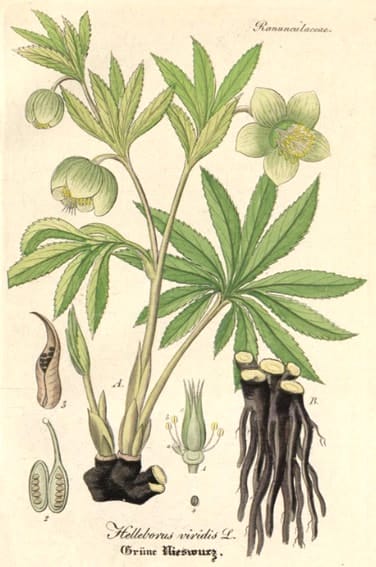
|
|
H. niger Nouvelle iconographie fourragère, Atlas, (1865-1871) |
H. viridis Hand-Atlas Medicinisch-Pharmaceutischer, 1884 |
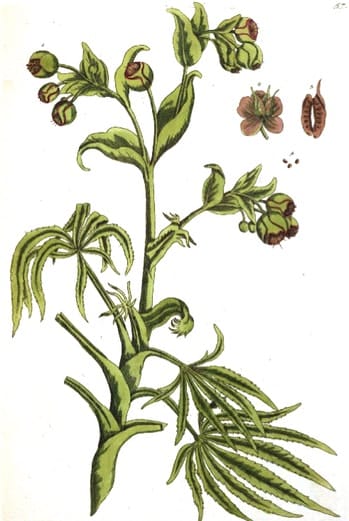
|
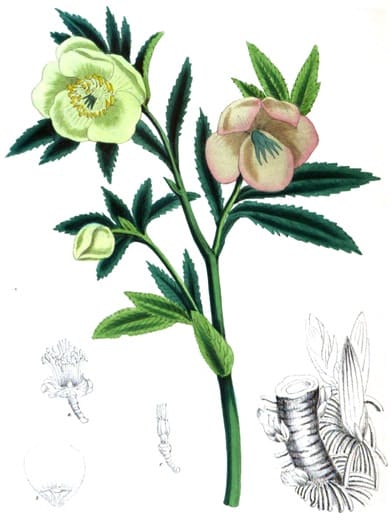
|
|
H. foetidus Herbarium Blackwellianum, 1750 |
H. orientalis An Encyclopaedia of useful and ornamental Plants, Burnett, 1852 |
 Roots of H. niger
Roots of H. niger(Hortus Eystettensis, 1613)
Botanical name:
Helleborus spp.
Several species have supplied the market:
1. H. niger (Black Hellebore)
2. H. orientalis
3. H. foetida (Foetid Hellebore)
4. H. viridus (Green Hellebore)
H. orientalis has been stated to be the original Melampodium (Hellebore) of the Greeks, and is used similarly to H. niger. However, a number of the ancient writers including Pliny specifically mention Black Hellebore which cannot be mistaken for related species. The supposition is possibly related to several species collected together to supply the market. A number of sources stated that H. foetida (Foetid Hellebore) and H. viridus (Green Hellebore) were collected indiscriminately with Black Hellebore, and shared identical effects, however H. foetida is the strongest of the three and should be avoided.
H. thibetanus Tie Kuai Zi (铁筷子) has been used in TCM. Its primary function is to clear Heat and Poison, promote Circulation and resolve masses. Used for Cough, Asthma, Cystitis, toxic Sores and Swellings, and for Blood stagnation and Bruising. It is also used for rheumatic bone pain. Its alkaloid profile is similar to H. niger so its functions and effects are probably similar.
There are around 20 species of Helleborus found between Europe and Asia. It appears a number of the species have been used similarly.
Parts used:
Prepared Root or Root-bark.
Pliny said the finer rootlets are only gathered, the large root like ‘an onion’ was only used to purge dogs.
Avicenna said “Black Hellebore has thin and black rootlets emerging from a single root (point) like the bulb of onion. These rootlets are used (in medicine) … The best kind of black hellebore is that which is neither old nor new, nor fat and nor thin. It should be ash-coloured, easy to break, not very dense and its innerside resembling a spider’s web. It should also be sharp in taste and irritant to the tongue. The best part of the drug to be used is the small branches, collected close to the roots, peeling off the barks and drying-up the latter in shade. The dried barks are then powdered, sieved and used“.
‘They must gather it, the Moon being in a happy aspect with Jupiter and Venus at the Sun rising, the Moon increasing, and in Capricorn, the Lion, or Sagittarius’. (Schroder)
The leaf is sometimes used and was mentioned by Salmon. The leaves can be prepared like the root.
Temperature & Taste:
Very Warm, dry. Bitter, Pungent. Toxic
“It is Hot and Dry in the Third degree”. (Avicenna)
Classifications:
2A APERIENT MEDICINES. 2F. PURIFYING. 2M. DRAWING
3P. MASTICATORIES & STERNUTATORIES. 3Q. ANTHELMINTIC
Uses:
1. Clears Damp, Purges Melancholy:
-all diseases coming from Melancholy: ‘as Madness, Hypochondriac diseases, Elephantiasis, Herpes, Cancer, Quartans’ (Salmon)
-‘useful in cases of excessive black bile, and evacuates it from all parts of the body without any difficulty’. (Avicenna)
-Madness, Depression, Schizophrenia, Insanity, various Mental disorders; Pliny listed Insanity
-‘It is useful in Evil thoughts‘ (Avicenna)
-Consumption of the Lungs or whole Body (Pemell, 1652)
-‘Used for possession, it will cast out the Devil’. (Pemell, 1652)
-Scabs; Psoriasis; Leprosy and other chronic skin diseases
2. Clears Wind–Phlegm, Stops Spasms:
-Apoplexy, Paralysis, Vertigo and Epilepsy
-useful in Paralysis and Epilepsy (Avicenna)
-spasmodic Asthma
3. Clears Wind and Damp, Eases Pain:
-various Arthritic complaints including Rheumatism, gout and Sciatica.
-chronic severe headache (a severe case from Childhood was cured in a women, Hauff, Württemb)
–Pliny and Avicenna listed it for chronic Arthritis and Joint disease.
-“It is useful in Paralysis and Arthralgia and the evacuation by its use is a very effective remedy for all such diseases”. (Avicenna)
4. Moves the Blood, Clears Stasis, Resolves Masses:
-internal Blood stagnation, Bruising
-Fibroid Tumors and Cancer.
-advocated in Cancers of the Brain, Prostate, in lymphoma and Leukemias, as well as other types of Cancer
-obstructed Menstruation
-previously much used as an Abortifacient.
5. Warms the Yang:
-‘One of the main properties of black hellebore is that it changes the temperament of the body and creates a new temperament of youthfulness and vigour’. (Avicenna)
-Edema; Eclectics used it for sudden edema of the skin with passive venous congestion of the Kidneys;
-chronic and obstinate cases of Edema
-‘I have used it with advantage in Sterility of the female, and to increase Virility in the male’. (Scudder, Specific Medicine, 1870)
–Heart remedy in the elderly (Brestowski, Pharmakologie und Toxikologie, Vienna, 1894)
-Paralysis of the lower extremities (Pardubice-Hofrova)
-classically regarded as a Longevity medicine.
-sharpens the Intellect (Pliny)
6. Clears Wind, Resists Poison:
-Meningitis with a tendency to edema, scanty urine, and with staring eyes.
-preventative for Malaria, and is used in treating chronic Fevers. (Unani)
7. Kills Worms
-Kill Worms and Parasites
8. Externally:
-topical application for various types of pain: ‘It also destroys sensation when used locally’.
-Ulcers, both in the beginning stages and for Foul Ulcers.
–Pliny said it cleanses and resolves Scrofulous Sores, Suppurations, Hard Tumours, and Fistulas
-powder put into Fistulas heals them (Pemell, 1652); very useful for removing callosity of Fistulas (Galen)
–Old wounds are sprinkled with the powdered root
-applied to the beginning of Gangrenes.
-boiled in vinegar and applied to Eczema, Leprosy, Morphew, Scabies, Warts (Pemell, 1652)
-applied to Shingles and Leprous sores (A Treatise on Foreign Drugs, Geoffroy and Thicknesse, 1749)
-also Pityriasis and Leucoderma (Avicenna)
-wash externally for Scabies, Lice and other Parasites. Salmon suggested washing the head with a hot decoction of Hellebore, then applying the ointment of Hellbore to destroy Lice.
-cataplasm of the root with Barley meal applied to the belly for Edema (Pemell, 1652)
-Arthritis, boil the herb or root in water and bathe with it (Pemell, 1652)
-2 or 3 drops of the juice or the decoction in vinegar dropped in the ear was said to cure Tinnitus
-‘”Ear drops o f its decoction remove dulness of hearing and strengthen the hearing power”. (Avicenna)
-powdered root used as a snuff excites sneezing
-a snuff of the root has cured Night-blindness.
-as a fomentation for films of the Eyes (Pliny)
-a liniment or ointment was applied to Redness of the Face, Wrinkles and Pimples.
-“When used as mouth wash with vinegar, it relieves Toothache”. (Avicenna)
-decoction gargled helps toothache (Pemell, 1652)
-distilled water used as a wash to clear dark spots, bruises, marks of the skin (Salmon)
Preparation:
Some recommended using the root-bark, the woody pith being removed. However, Pliny said only the fine rootlets are used, the main root being rejected. Evidently, if the large root is used, only the bark should be chosen; otherwise, the entire root with rootlets can be used.
1. The most usual method of preparation was to steep the sliced root in vinegar for 24 hours, then dry
2. Prepare by steeping overnight in Quince juice, Vinegar of Quinces (which is best) or Wine of Quinces, then dried for use.
3. Dried roots can be sprinkled with Damask Rose juice and dried in the Sun, this being repeated thrice.
4. Some sources said the root should be aged before use, and it should be laid in leaven for 20 days before using. (Pemell, 1652)
5. See below for other preparations.
Dose:
1. Only the prepared root should be used internally. Some modern physicians have used the unprepared root but traditional preparation is milder, safer, and more effective.
2. The powder is more dangerous; decocted it is safer.
3. Maximum recommended single dose (of the unprepared root) is 200mg; maximum daily dose is 1 gram
4. ‘Suitable for men, women having masculine temperament, young and vigorous persons with a well nourished body and abundant blood’. (Avicenna)
5. ‘Persons who desire to take black hellebore should abstain from all heavy food and drinks for three days. They should enjoy spending most of the time in merriment and amusement. Moreover they should vomit twice or thrice after dinner and then take this drug’. (Avicenna)
6. “Sometimes it is taken as a drink prepared in the following way. It is soaked in oxymel or any other sweet wine for a long time and thereafter this wine is decocted with lentil or barley or chicken (soup) and then sipped”. (Avicenna)
UNPREPARED ROOT in POWDER: As an alterative, 100–200mg; as a purgative, 200–500mg.
PREPARED ROOT in POWDER: 500mg–1 gram (1–2 scruples, Salmon, Pemell), best taken with Honey or in Oxymel. 10–20 grains were traditionally used to purge;
EXTRACT: 3–10 grains; Salmon said the extract was milder and could be taken in doses of 1 scruple to 1 dram. However, the extract he refers to is probably boiled down, whereas the dose of 3–10 grains is probably following the later method of extract preparation, being extracted with alcohol and evaporated, meaning no heat has been used.
TINCTURE (1:10): 20–60 drops.
DISTILLED WATER: 1 dram in 3 oz. of White Wine.
DECOCTION: 1–2 drams decocted in a pint of water, taken in 1 oz. doses.
Correctives:
1. Mastic, Aniseed, Cinnamon, Cloves, Fennel seed (½ scruple of any one to 1 dram of Hellebore)
2. Oregano or Rosemary.
3. In Unani, Mastic, Tragacanth and Almond oil are used.
4. Pliny said it was best taken with Salt.
5. Some liked to use it with Scammony or other purgatives to accentuate it and simultaneously removing it from the body after working.
6. Corrected with Diacytonium (Electuary of Quince)
Substitute:
1. Mezereon and White Agaric, half part and two-thirds part respectively. (Avicenna)
2. White Hellebore in half dose was recommended by Mesue.
3. Picrorhiza in Liver disorders
4. Azurite: ““After its [Azurite] (therapeutic) recognition, the use of Black Hellebore for the treatment of Melancholic diseases was abandoned”. (Avicenna)
Main Combinations:
Melancholy:
1. Prepared Black Hellebore with Calamus, Galangal, Saffron and Cardamon for Headache, Melancholy, Asthma, Mania, Mental Illness (as in Tincture of Black Hellebore)
2. Schroders Syrup of Hellebore: prepared Black Hellebore root-bark 6 drams, Rhubarb 16 drams, Senna, Polypody of each 32 drams; with sufficient Wine and Honey, form a Syrup.
3. To purge in Melancholy diseases:
i. decoct prepared Black Hellebore with Aniseed and Fennel seed.
ii. Powder: Hellebore root (1 dram), Aniseed, Fennel seed, Cinnamon, Mastic (10 grains each) (Pemell, 1652)
iii. Infusion: Hellebore bark (2 drams), Aniseed, Fennel seed (1 dram), Cinnamon, Clove (3 grains), infuse in water or wine, take in 3 oz. doses. (Pemell, 1652)
iv. for Pituitous and burnt Humors, prepared Black Hellebore with Chebulic Myrobalan, Black Myrobalan, Dodder (as in Infusion for Pituitous and Burnt Humors with Hellebore)
v. prepared Black Hellebore with Cream of Tartar, form a bolus with Syrup of Quince. (A Treatise on Foreign Drugs, Geoffroy and Thicknesse, 1749)
vi. prepared Black Hellebore with Dodder, Polypody, Agaric, Scammony, Rock Salt, Clove, Aniseed, Hiera Picra (as in Pills of Lapis Lazuli)
vii. Syrup of Black Hellebore with Decoction of Polypody root, Thyme, and Dodder (Herbarium Horstianum, 1630)
4. To purge Mixed Humors:
i. prepared Black Hellebore with Ginger, Cinnamon, Aniseed, Mastic, Camphor
ii. prepared Black Hellebore with Rhubarb, Yellow Myrobalan, Chebulic Myrobalan, Black Myrobalan, Agaric, Ginger, Aniseed, Cinnamon, Mastic, Gum Arabic, Siler Montane (as in Infusion for Mixed Humors Compound of Mesue)
5. Melancholy, Fear, Mental Illness, prepared Black Hellebore root with Syrian Rue, Polypody, Horehound, Dodder, Stoechas Agaric, Clove Basil seed, Balm, Citron peel, Bugloss, Nutmeg
6. Melancholy, Mania, Black Hellebore fine rootlets [1 oz.), boil in water 4 oz. to 3 oz. Add clarified Honey (2 oz.), mix. Take a spoonful in fat broth every second day. (Tractatus de materia medica, Geoffroy, 1741)
7. ‘Religious Madness’, prepared Black Hellebore with Camphor, Valerian, Camomile, Gratiola, Asafetida, Cinnamon (Schneider, report of a case that was cured, Hufelands Journal)
Wind Diseases:
8. Vertigo, Wind diseases, prepared Black Hellebore with Aloeswood Saffron Aniseed Mastic Marjoram Agaric Orris Stoechas Turbith
9. Epilepsy:
i. Mistletoe, Dittany of Crete (20 each), prepared Black Hellebore root, Valerian (10 each), Nerium oleander (15), with Honey (50), form an electuary; Dose: quarter teaspoon, twice daily. (Landerer)
ii. Hiera Picra, Dodder, Lapis Lazuli, Scammony, prepared Colocynth, prepared Black Hellebore prepared, Indian Spikenard
Obstructions:
10. Edema, Amenorrhea, Mania, Melancholy; Extract of Black Hellebore, Extract of Myrrh (1 dram each), Powder of Blessed Thistle, sufficient to form 60 pills. Dose: 4–6 pills twice daily. (Bucher)
11. Ascites, Black Hellebore extract, Gum Ammoniac, Celandine extract, Rhubarb, Calamus (Sobernheim, 1840)
12. Jaundice, decoct prepared Black Hellebore with Rue and Agrimony (Gerard)
13. Obstruction of the Liver or Spleen, prepared Black Hellebore root, Ammonium chloride, Wormwood, Mint
Tumors:
14. Scrofula:
i. prepared Black Hellebore with Butchers Broom, Asparagus root, Polypody root, Violet root, Marshmallow, Orris, Tragacanth, Calamus, Stoechas, Peony, Figwort (as in Wine for Scrophula)
ii. prepared Black Hellebore with burnt Sponge, Cuttlefish bone, Long Pepper, Ginger, Cinnamon, Rock Salt, Pellitory, Gall, Pumice, Plantain seed (as in Powder for Scrofula)
15. Cancer:
i. prepared Black Hellebore with Mistletoe. (Anthroposophic Medicine)
ii. prepared Black Hellebore with Calomel and Myrrh (Theatrum Praxeos Medicae, Zuingerus, 1710)
External:
16. Deafness:
i. Ear drops of its decoction strengthen Hearing. (Avicenna)
ii. Black Hellebore with as a topical oil with Senna, Bay leaf, Rosemary, Marjoram
17. Tinnitus, decoct in vinegar and drop into the ear. (Avicenna)
18. Toothache:
i. decoct in vinegar and drop into the ear. (Avicenna)
ii. decoct in vinegar and use as a mouth wash.
19. Headache, prepared Black Hellebore with is used as a snuff with Orris root
20. To clear Spots of the Face, prepare a powder of Orris root (2 drams), Black Hellebore root (1 dram), mix with Honey and apply to the face before bed, washing off with warm water in the morning. (The Secrets of Alexis, 1615)
21. Pityriasis nigra, apply the root with vinegar (Avicenna)
22. Fistula, the powdered root mixed with honey cures in 3 days. (Herbarius latinus, Petri, 1485)
23. Hardness of the Vagina or Uterus, a piece of the root left in for 2 or 3 days was said to totally consume it. Galen mentioned it, as did Julius Alexandrinus, and it was still followed into the 18th century.
Major Formulas
Infusion for Pituitous and Burnt Humors with Hellebore (Mesue)
Infusion for Mixed Humors Compound (Mesue)
Decoction of Dodder of Thyme (Mesue)
Syrup to Purge all Humors of Frankfurt
Wine for Scrophula (Renodeus)
Powder for Mixed Humors (Mesue)
Powder for Scrofula (Wirtzung)
Powder for Scrofula (Bononiense)
Indian Pills (Mesue)
Purge to be Taken in Cancer
Electuary for Vehement Pituitous and Burnt Bile Humors
Electuary of Black Hellebore (Zenon)
Electuary for Melancholy and Fear of Filius Zacharia
Electuarium Acharistum (Nicholas)
Antidotum Haemagogum (Nicholas)
Indian Pills (Mesue)
Pills of Lapis Lazuli-1 Mesue
Pills for Melancholy (Unani)
Pills for Epilepsy from Melancholy of Serapion
Pills for Uterine Fibroids
Expert Pills for Epilepsy from Phlegm
COMPOUND TINCTURE of BLACK HELLEBORE.
Prepared Black Hellebore root 1½ oz.
Calamus aromaticus 2 oz.
Galangal ½ oz.
Saffron 1½ drams.
Cardamons 3 drams.
Canary or Spanish wine 4 lbs.
Macerate in a closed vessel for 24 hours in a warm place, then in a cold place for 4, 5, or 6 days; then press and filter. This is a well corrected medicine.
‘Of single use for distempers of the Head, Headaches, Melancholy, Asthma’s &c.’
‘Of great use for such as are Maniacal, or troubled with Madness, especially that kind of Madness which proceeds from a profound or deep Melancholy; for which, and all Obstructions and Oppressions of the Spleen, Discontents, vain Fears and foolish Fantasies and Imaginations, it is a specific, and a very excellent thing … It is an excellent remedy against most diseases of the Head and Brain, as Headaches, Megrims, Vertigo’s, Apoplexies, Lethargies, Carus, Palsies and such like; for it attracts and carries forth the Cold, Moist, and Morbistic Matter of the Disease, and leaves the parts disburthened of their load’. (Salmon)
It was also used for some cases of Coughs, Asthma, Wheezing, shortness or difficulty of breath, as well as loathing of food, sickness of the stomach etc.
Dose: 2 spoonfuls at bedtime and 3 in the mornings for some days. (Pharmacopeia Bateana, and Pharmaceutical Journal, 1905)
Cautions:
1. Very Toxic in overdose. Less Toxic after preparation, and when decocted.
2. Should only be used in classical formula.
3. Not used in Pregnancy, or used in Children, or the Elderly, or the very Weak. Generally only used in the strong.
Avicenna noted it is ‘unsuitable for cowards and persons having flabby bodies’.
4. Pliny said used for Paralysis, Insanity and Edema ‘provided there is no Fever’. He also said it shouldn’t be used in internal Ulcers, particularly in Spitting of Blood.
5. ‘This is not so violent as the former [White Hellebore], yet a very dangerous purge, working both upwards and downwards: very strongly purging Melancholy’. (Salmon)
6. ‘It ought to be given with great Caution, and to strong Bodies; the gross body is perilous, in Decoction it is less dangerous: it is corrected with Cloves, Cinnamon, Aniseed, Fennel seed, Rosemary &c.’ (Salmon)
Drug Interaction
1. Not used by those taking Heart medication.
Antidote:
1. Water Lily flower, dried and powdered, 2 drams (De venenis, Petrus, 1487)
2. “Persons who harvest it, take Garlic and Wine as a precautionary measure against its harms”. (Avicenna)
Poisoning:
Fuerth (Medical Clinic, 1905) describes a poisoning by Hellebore in a boy of fifteen years. ‘There was immediately violent burning on the tongue, a little later headache, dizziness, scraping and choking in the pharynx and in the esophagus. The pulse was slight, arthythmic, the sensorium slightly distensed, the pupils dilated. In the further course of sleep, headache and burning thirst occurred. The recovery took place after six days’.
Main Preparations used:
Cakes, Syrup, Potion
Various Extracts were made (see below), used in various Pills to purge Melancholy; also Syrup and Oxymel of Hellebore
1. Cakes of Black Hellebore Leaf Juice:
Mix the leaf juice with flour, make into small cakes and bake. Used for Edema, Jaundice, Cachexia etc. Dose is half to 2 drams, according to strength. (Salmon)
2. Syrup of Black Hellebore:
i. Black Hellebore root (1 oz.), boil in Rain Water (4 oz.) to a third part. Strain, add clarified Honey (2 oz.). Dose: 1 spoonful every second day in Madness. (A Treatise on Foreign Drugs, Geoffroy and Thicknesse, 1749)
3. Oxymel of Black Hellebore
i. Form a Decoction, then with Honey and Vinegar, form an Oxymel
4. Potion for Melancholy:
i. Black Hellebore root (2 drams), decoct in enough water to give 8 oz. of strained decoction, dissolve in Cream of Tartar (1 dram), and clarified Honey (2 oz.). Dose: 1 tablespoonful at a time. (Reil)
Extra Preparations
|
An Extract Made with Wine ‘The bark of the root (casting the sticky pith away) and the Fibers, boil them gently in Wine 3 hours, then increase the fire a while longer, strain out by pressing and coagulate. Dose: ½–1 dram’ (Salmon, Seplasium) Sala’s Extract ‘Bark of Black Hellebore half pound., Borage water 3 pounds, S.V. [brandy] 4 oz., digest and extract in a close [sealed] vessel, strain out by pressing, add the Salt of the Feces [salt extracted from the ashes of the extracted root], digest a day and coagulate. Dose: 1 scruple’ (Salmon, Seplasium) |
Closseus’s Extract ‘Fibers of Black Hellebore of a purple color, dry them in a frying pan over a gentle fire (that the malignant vapours causing convulsions may exhale) then powder them, and with Phlegm of Vitriol, or distilled Vinegar, extract a Tincture; filter and coagulate’. Dose: to ½ dram. (Salmon, Seplasium) |
Pliny on Hellebore:
|
‘The repute of Melampus, as being highly skilled in the arts of divination, is universally known. This personage has given a name to one species of hellebore, known as the “melampodion.” Some persons, however, attribute the discovery of this plant to a shepherd of that name, who remarked that his she-goats were violently purged after browsing upon it, and afterwards cured the daughters of Proetus of madness, by giving them the milk of these goats. It will be the best plan, therefore, to take this opportunity of treating of the several varieties of hellebore. The two principal kinds are the white and the black; though, according to most authorities, this difference exists in the root only. There are some authors, however, who assure us that the leaves of the black hellebore are similar to those of the plane-tree, only darker, more diminutive, and more jagged at the edges: and who say, that the white hellebore has leaves like those of beet when first shooting, though at the same time of a more swarthy colour, with reddish veins on the underside. The stem, in both kinds, is ferulaceous, a palm in height, and covered with coats like those of the bulbs, the root, too, being fibrous like that of the onion. ‘The black hellebore kills horses, oxen, and swine; hence it is that those animals avoid it, while they eat the white kind. The proper time, thay say, for gathering this last, is harvest. It grows upon Mount Eta in great abundance; and the best of all is that found upon one spot on that mountain, in the vicinity of Pyra. The black hellebore is found growing every where, but the best is that of Mount Helicon ;which is also equally celebrated for the qualities of its other plants. The white hellebore of Mount Eta is the most highly esteemed, that of Pontus occupying the second place, and the produce of Elea the third; which last, it is generally said, grows in the vine yards there. The fourth rank is held by the white hellebore of Mount Parnassus, though it is often adulterated with that of the neighbouring districts of Aetolia. ‘Of these kinds it is the black hellebore that is known as the “melampodium “; it is used infumigations, and for the purpose of purifying houses; cattle, too, are sprinkled with it, a certain form of prayer being repeated. This last plant, too, is gathered with more numerous ceremonies than the other: a circle is first traced around it with a sword, after which, the person about to cut it turns towards the East, and offers up a prayer, entreating permission of the gods to do so. At the same time he observes whether an eagle is in sight— for mostly while the plant is being gathered that bird is near at hand— and if one should chance to fly close at hand, it is looked upon as a presage that he will die within the year. The white hellebore, too, is gathered not without difficulty, as it is very oppressive to the head; more particularly if gathered that bird is near at hand— and if one should chance to fly close at hand, it is looked upon as a presage that he will die within the year. The white hellebore, too, is gathered not without difficulty, as it is very oppressive to the head; more particularly if the precaution has not been used of eating garlic first, and of drinking wine every now and then, care being taken to dig up the plant as speedily as possible. ‘Some persons call the black hellebore “ectomon,'” and others “polyrrhizon :” it purges by stool, while the white hellebore acts |
as an emetic, and so carries off what might otherwise have given rise to disease. In former days hellebore was regarded with horror, but more recently the use of it has be come so familiar, that numbers of studious men are in the habit of taking it for the purpose of sharpening the intellectual powers required by their literary investigations. Carneades, for instance, made use of hellebore when about to answer the treatises of Zeno; Drusus too, among us, the most famous of all the tribunes of the people, and whom in particular the public, rising from their seats, greeted with loud applause— to whom also the patricians imputed the Marsic war— is well known to have been cured of epilepsy in the island of Anticyra; a place at which it is taken with more safety than else where, from the fact of sesamoides being combined with it, as already stated. In Italy the name given to it is “veratrum.” These kinds of hellebore, reduced to powder and taken alone, or else in combination with radicula, a plant used, as already mentioned, for washing wool, act as a sternutatory, and are both of them productive of narcotic effects. The thinnest and shortest roots are selected, and among them the lower parts in particular, which have all the appearance of having been cut short; for, as to the upper part, which is the thickest, and bears a resemblance to an onion, it is given to dogs only, as a purgative. The ancients used to select those roots the rind of which was the most fleshy, from an idea that the pith extracted there from was of a more refined nature. This substance they covered with wet sponges, and, when it began to swell, used to split it longitudinally with a needle; which done, the filaments were dried in the shade, for future use. At the present day, however, the fibres of the root with the thickest rind are selected, and given to the patient just as they are. The best hellebore is that which has an acrid, burning taste, and when broken, emits a sort of dust. It retains its efficacy, they say, so long as thirty years. ‘Black hellebore is administered for the cure of paralysis, insanity, dropsy— provided there is no fever— chronic gout, and diseases of the joints: it has the effect too, of carrying off the bilious secretions and morbid humours by stool. It is given also in water as a gentle aperient, the proportion being one drachma at the very utmost, and four oboli for a moderate dose. Some authorities have recomended mixing scammony with it, but salt is looked upon as more safe. If given in any considerable quantity in combination with a sweet substance, it is highly dangerous: used in the form of a fomentation, it disperses films upon the eyes; and hence it is that some medical men have pounded it and used it for an eye-salve. It ripens and acts detergently upon scrofulous sores, suppurations, and indurated tumours, as also upon fistulas, but in this latter case it must be removed at the end of a couple of days. In combination with copper filings and sandarach, it removes warts; and it is applied to the abdominal regions, with barley-meal and wine, in cases of dropsy. ‘This plant is employed for the cure of pituitous defluxions in cattle and beasts of burden, a slip of it being passed through the ear, and removed at the same hour on the following day. With frankincense also, wax, and pitch, or else pisselseon, it is used for the cure of itch in quadrupeds. |
Pharmacographia, Fluckiger & Hanbury, 1879:
|
‘The story of the daughters of Proetus, king of Argos, being cured of madness by the soothsayer and physician Melampus, who administered to them hellebore, has imparted great celebrity to the plant under notice. ‘But admitting that the medicine of Melampus was really the root of a species of Helleborus, its identity with that of the present plant is extremely improbable. Several other species grow in Greece and Asia Minor, and Schroff has endeavoured to show that of these, H. orientalis Lam. possesses medicinal powers agreeing better with the ancient accounts than those of |
H. niger. He has also pointed out that the ancients employed not the entire root but only the bark separated from the woody column; and that in H. niger and H. viridis the peeling of the rhizome is impossible, but that in H. orientalis it may be easily effected. ‘According to the same authority the hellebores differ extremely in their medicinal activity. The most potent is H. orientalis Lam.; then follow H. viridis L. and H. foetidus L. (natives of Britain), and H. purpurascens Waldst. et Kit., a Hungarian species, while H. niger is the weakest of all. |
